Choosing a yarn for hand knitting without knitting needles

Unlike knitting or crocheting, hand knitting does not require any special skills. Knitting on the hands is quick and without special patterns. You can knit on your hands using a simple surface technique, without complex patterns. Despite the simplicity of the process, you can knit beautiful original things on your hands. This will take a little patience and experience. But a lot also depends on the choice of yarn, its quality, fiber composition and thickness.
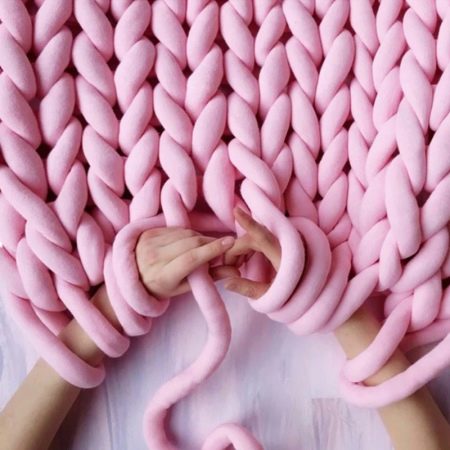
general description
The choice of yarn for hand knitting will depend on the preferences of the needlewoman and the product chosen. The yarn differs in the material from which it is produced, the thickness of the fibers and the number of meters in a skein. The choice of thread will determine the quality of the product, its durability, appearance and way of caring for it.
Today, in specialized stores for needlework, a wide selection of yarn for knitting by hand is presented. Even the most demanding craftswoman will be able to choose the right material and color for working without knitting needles and knit an original thing.
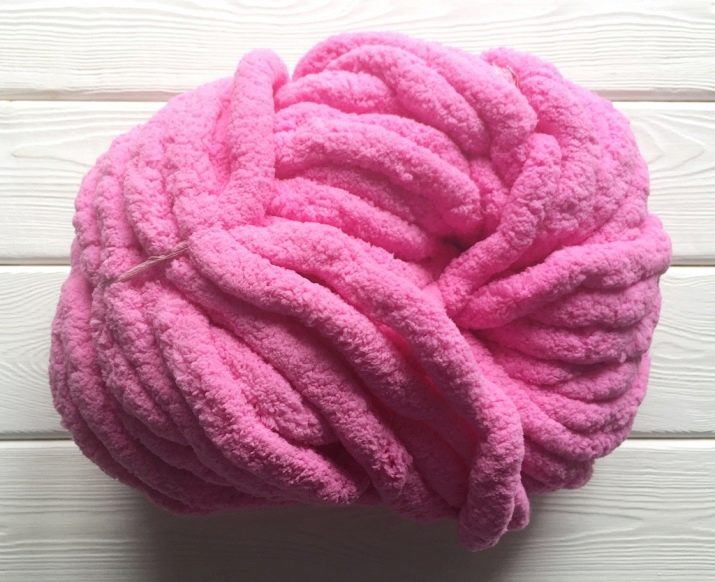
The yarn is made from threads, and the threads, in turn, are made from fibers. The yarn can be composed of a single strand or several. The threads can be smooth or textured. Fibers differ in raw materials: natural or artificial. Before forming the filaments, the fiber goes through a series of processing procedures. It is cleaned, combed, steamed, shaped and then twisted into a thread.
The variety of yarn choices, colors, thickness and texture can scare novice needlewomen.

When choosing, you need to pay attention to the label, which indicates the composition, length in a skein and method of care.
Types and composition
Threads of different composition have different properties, as well as products made from them. Therefore, it is important to choose the correct yarn composition for the selected product. For example, products made of woolen thread with the addition of synthetic fibers will be more elastic and keep their shape better. And fully synthetic acrylic is suitable for knitting children's clothes, because it is hypoallergenic.
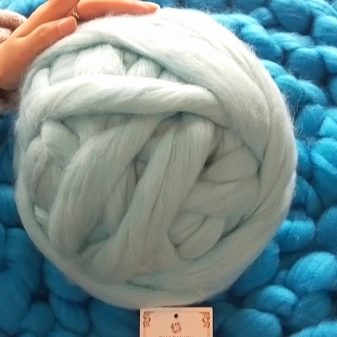

According to the composition, the threads are divided into 3 types
- natural;
- synthetic;
- mixed.


Natural thread is made from animal hair or natural plant fibers. Natural yarn keeps heat well and allows air to pass through, does not electrify and is suitable for knitting warm winter clothes. The most popular natural wool yarns are mohair, angora, cashmere and sheep wool. Angora and cashmere are very expensive yarns and require careful handling and care. Angora products are very downy, which creates additional inconvenience when worn.

Linen, silk and cotton are produced from plant fibers. This thread is cheaper than woolen thread and does not require such careful maintenance (except for silk). Products made from plant fibers are pleasant to the touch, have high wear resistance and retain an attractive appearance for a long time.
Synthetic thread is made from synthesized fibers; it is a chemical product. Synthetic fibers are more often used as an additive to natural threads to give strength and elasticity.

Blended yarn combines two or more types of fibers and is most often found on store shelves.
A product made of blended yarn acquires all the positive qualities of the threads included in it, becomes softer, more elastic, resistant to shrinkage and wear.
Over the past decades, many new yarn products for needlewomen have appeared on the market:
- fantasy;
- melange color;
- volumetric;
- metallized and much more.


Fantasy yarn - a thread with a varied texture along its entire length. These can be voluminous parts (pompons) or small ones (boucle, bumps). This yarn is suitable for processing the edges of the product, creating an unusual fabric.

Melange yarn has a gradient color, when shades of the same color smoothly blend into each other.

Bulky yarns are characterized by uneven thickness along the length of the skein. This helps to create an unusual textured canvas. Products made from such a synthetic thread are soft, easily wrinkled and quickly return volume. You can knit a blanket, bedspread or pillows from it, which will appeal to all household members.

And in metallized yarn add shiny threads (lurex), giving an unusual shine to the product. Elegant festive things are obtained from it.
Yarn is divided not only by the origin of the fibers, but also by the appearance of the thread of which it is composed. Hand knitting threads are distinguished by their thickness and bulk, which allows them to be intertwined with hands or fingers. Better quality things are obtained from mixed fibers, they retain their shape longer, and they are more comfortable to knit.

Thick roving
Roving is a thick, loose thread that is obtained after being pulled from carding machines before the twisting step... This type of thread has gained popularity only in recent years. Thick and super thick thread is very suitable for handicraft, allowing you to create trendy knits in large knits.
Thick roving consists of 100% natural wool, without the addition of synthetic fibers. The products are very warm, with excellent breathability. But they require careful care, they quickly lose their shape. Due to the lack of braided fibers, pellets appear on the surface when using the product.


Large items made from thick rovings are heavy. Natural wool can cause an allergic reaction.
Due to the looseness and bulk of the threads when knitting, it is almost impossible to create a pattern or weave braids into the fabric. Most often, craftswomen use a thick roving for knitting with a simple satin stitch.When knitting by hand with a thick roving, the loops remain free, so the process requires skill to keep the loops relatively flat and not unravel. Due to the decent weight, the process can take more physical effort than regular knitting.

When choosing a thick roving, pay attention to the quality of the yarn, the threads may be of uneven thickness along the entire length and contain knots or breaks... You also need to be careful when storing roving so as not to damage the delicate threads. When buying, it is better to give preference to proven specialized stores and well-known companies with a good reputation.

Knitted tape
This type of yarn is created on specialized machines. Ribbon yarn is usually 100% natural cotton. The elastic band is convenient for knitting by hand. There are 2 types of knitted tape:
- primary, is made specifically for needlework and has no knots along the entire length of the skein;
- secondary, is made from the remains of weaving, may have knots and an uneven color - you can make such a tape yourself by cutting knitted items (for example, T-shirts).


When knitting with a knitted ribbon without tools, it is better to use finger knitting technique, when the loops are typed not on the hands, but on the fingers. The technique is very simple and quickly mastered. This technique can be used to create rugs, small pillows, toys and ottomans, backpacks and summer handbags.
When using a knitted tape, take into account the shrinkage caused by the cotton thread. The garment shrinks slightly after washing.

From loops
Specially designed yarn for hand knitting... Along the entire length of the thread, there are special loops that need to be intertwined. This is how the canvas is formed. The only manufacturer of such yarn today is the Turkish company Alize, the yarn is called Puffy... The yarn is pleasant to the touch, soft and plush. Allows you to knit warm, but at the same time lightweight products (for example, a blanket or bedspread). With a little experience and knowledge of the simplest knitting patterns, you can create patterns or volumetric braids on the canvas.
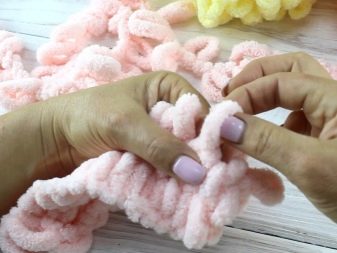
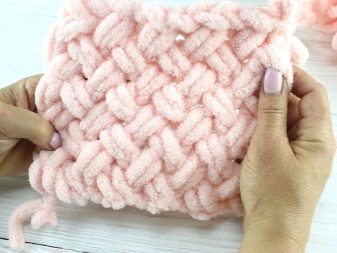
Advantages include the softness of the yarn and easy care for it. The yarn is thick, the process of knitting bulky things does not take much time. And hand knitting does not require special skills, such as knitting or special machines.
The biggest drawback of Puffy yarns is the 100% synthetic composition. It is more suitable for creating interior knitwear and toys than for creating garments.

Plush
Thick fluffy yarn is pleasant to the touch and comfortable to knit without additional tools. The smooth thread lies flat when knitting, does not tangle and does not irritate the skin.
From a thick thread, voluminous things (blankets, capes and rugs) are quickly created. Toys are often knitted from it. Yarn and products made from it do not require complex additional care, keeping their shape and appearance. Soft, bulky yarn allows small errors in the knitting technique, hiding imperfections and irregularities.

Pomponnaya
This fancy yarn has small pompom-like seals along its entire length. When weaving threads, pompons merge into a single canvas, leaving voids here and there. From this yarn, original interior items are obtained that are unlike anything else. Most often they are used to create blankets and bedside rugs in children's rooms. It also makes funny hats, scarves and snoods. Often, house slippers, socks and booties are knitted from pompom yarn.
Due to the small thickness of the threads, it is better to use the finger knitting technique, so the canvas will turn out to be smoother and more beautiful.


Top manufacturers
The quality of the product from it directly depends on the quality of the yarn, how long it will last, whether it will lose its shape and color or shrink, or maybe it will turn out to be prickly or leave fluff. Also, the convenience and speed of the craftswoman's work will depend on the quality of the material for knitting. Therefore, it is so important to choose high-quality yarn, and therefore, to trust the manufacturer... On the market you can find a huge variety of yarns of both elite quality with an appropriate price and economy options.
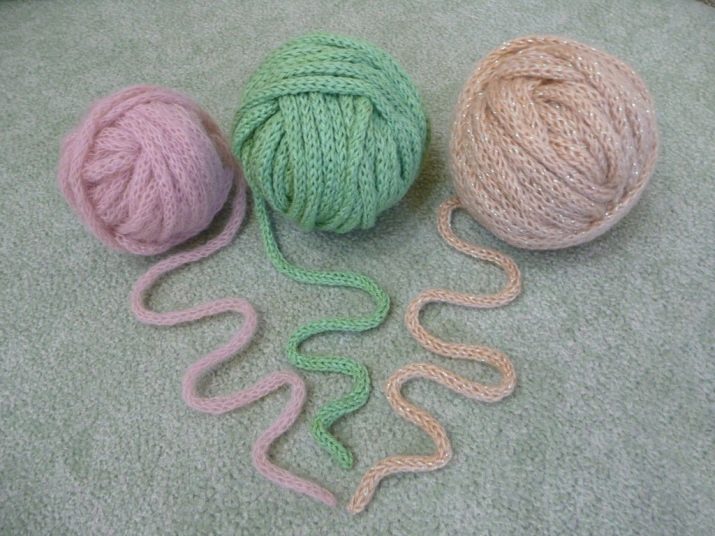
The most popular company producing yarn for hand knitting is the Turkish factory Alize. It is the only manufacturer of Puffy loop yarns. The company offers more than 70 thread colors and several textured solutions. There is an option with a longer pile, which imitates short fur.

The Russian factory "Lenta" is engaged in the production of knitted ribbons. From production in Russia, one can also note the well-known brands of Semenovskaya and Troitskaya yarns, Pekhorka and Serpantin. The budget options of these firms have gained popularity and love of craftswomen throughout Russia. Troitsk worsted factory specializes in the production of thick roving using Altai raw materials. The firm competes with it, Cloudly, which offers a huge range of colors and affordable prices.
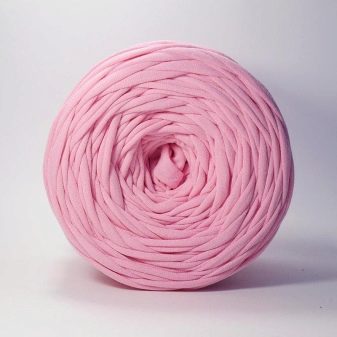

Of the foreign manufacturers, needlewomen are most often distinguished by the German firms Schachenmaur and Vita, which produce yarn for hand knitting.... High quality and variety of colors are the distinctive features of these companies. The material is resistant to wear and tear and the colors stay vibrant for years.
Premium yarn for hand knitting is produced by the English company Rowan. Its products are used by eminent designers to create knitted collections. The yarn is distinguished by unsurpassed English quality and restrained classic colors.

Selection Tips
For beginner needlewomen who are just mastering the knitting technique without tools, it is better to choose cheap options. It will not be a pity to train your skills on such yarn, while repeatedly ripping the canvas. For a start, it is better to choose an even yarn, without lint and fluff.
As your skills improve, you can purchase more expensive and higher quality yarn and create a really attractive thing. Then you will not be sorry for the money and time spent.

The material of the threads depends on your preferences and the chosen product. For interior products, you can choose mixed or synthetic threads, they will last longer and will not lose their appearance. And for clothes, it is better to choose natural or mixed threads, so things will retain heat and air exchange. The thickness of the yarn must be at least 3 mm.
When buying, be sure to read the label, calculate how many skeins you need for the product. Pay attention not only to the size and weight of the skein, but also to the length of the thread in it. Find out about the composition and the correct way of caring for yarn and a product made from it.
The main advice is to clearly imagine the finished product. The choice of yarn will depend on the necessary qualities of the desired thing. If you are not sure of the correct selection, then it is better to ask for advice from experienced craftswomen or a consultant in the store.









